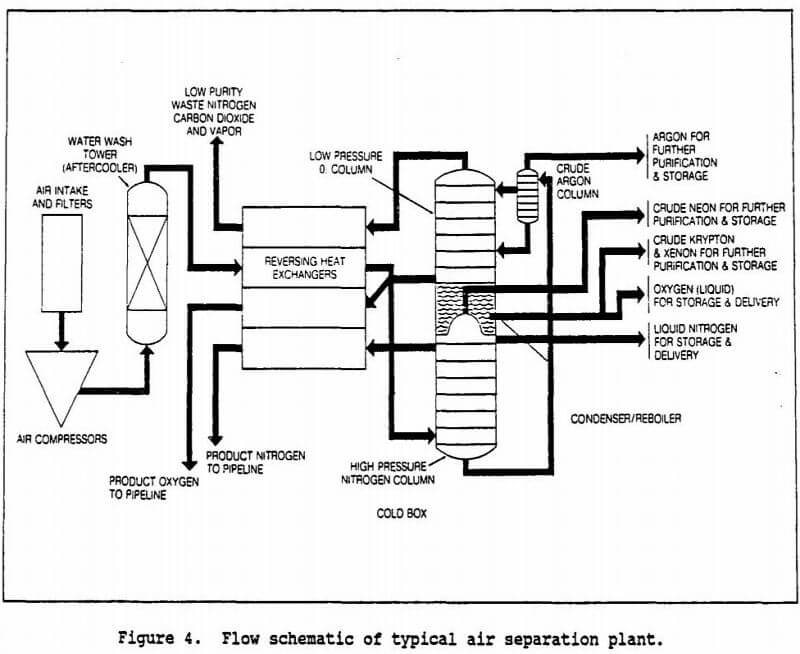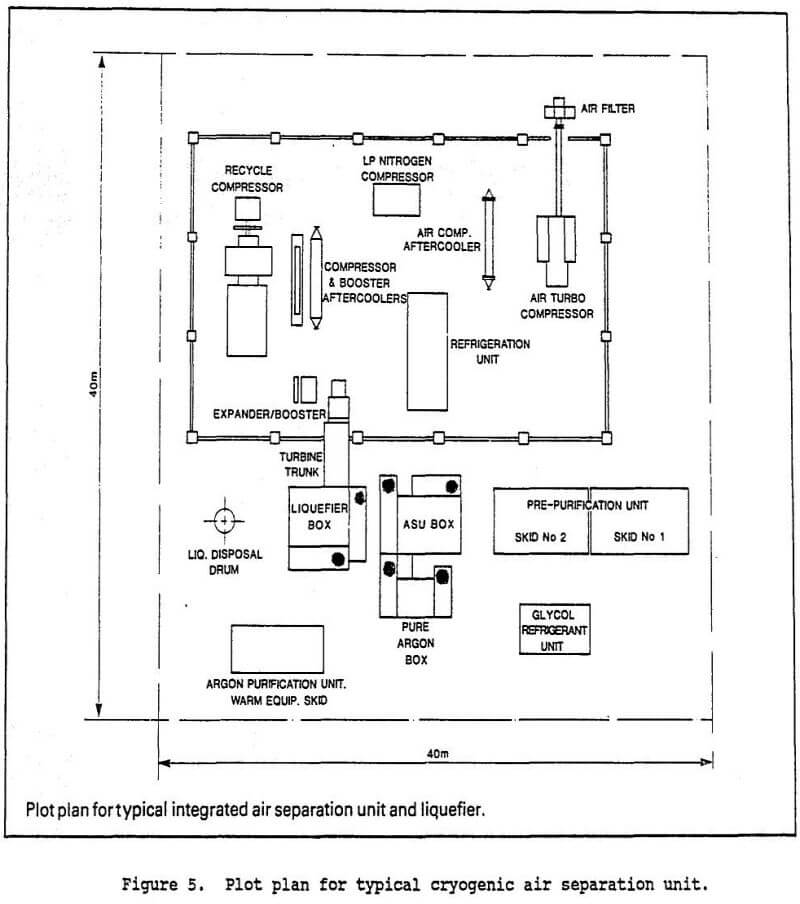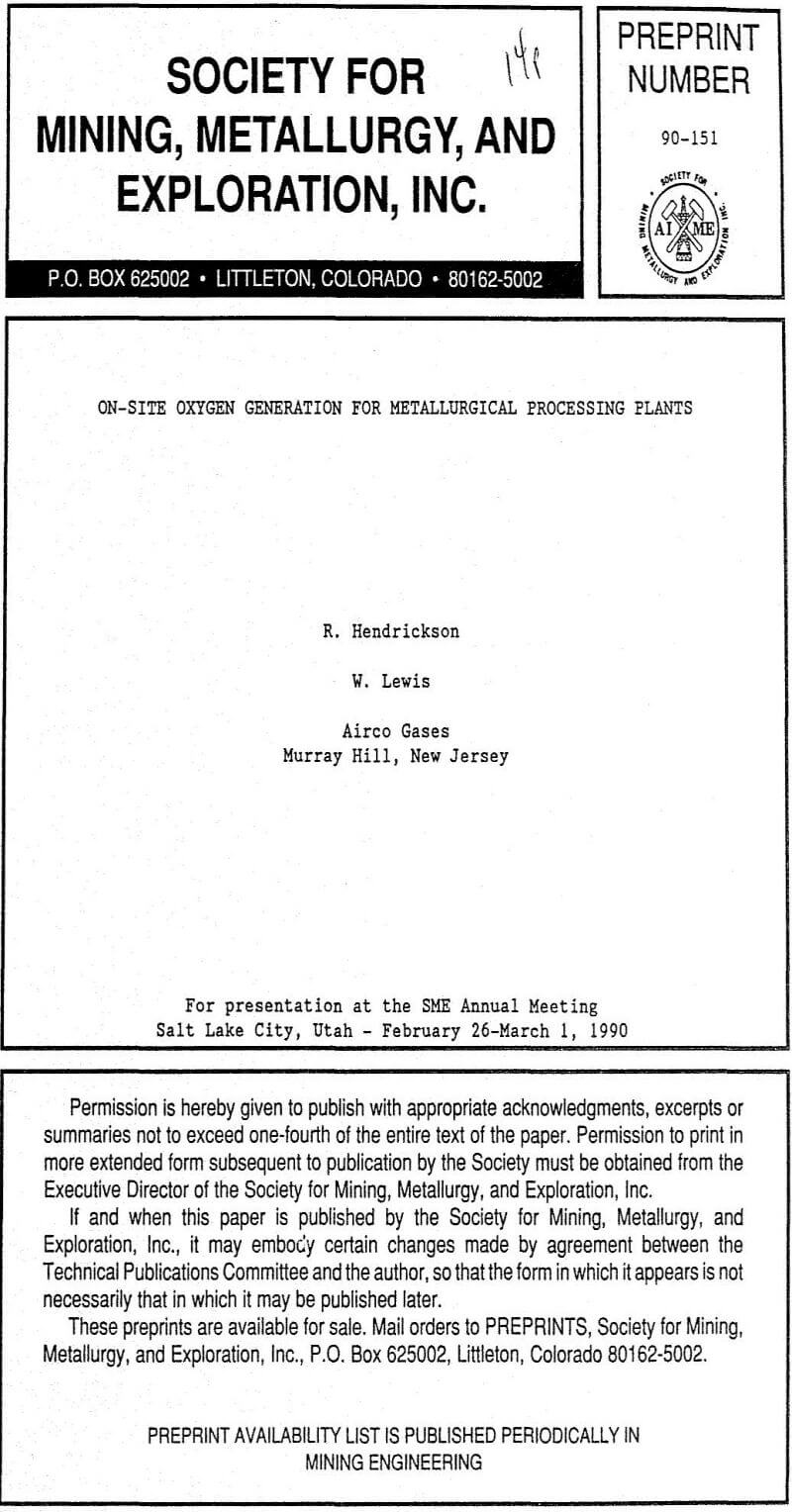In the 1940’s a top blown water-cooled oxygen lance was developed to inject oxygen into liquid iron. This process, the LD or BOF process technique, today is used in 65% of the world’s steel production, and represents the largest oxygen market for temperature enhancement in steel and non-ferrous smelting applications.
There are three major approaches to the use of oxygen in metallurgical processes: (1) general enrichment of the air supplied to burners or tuyeres, (2) under-flame enrichment or injection, and (3) the use of an auxiliary oxy-fuel burner as a heat source, with each of these techniques there are technical and economic trade-offs.
The simplest use is general enrichment of an air stream through a tuyere or air-fuel burner. It requires only simple flow control and distribution equipment. However, there are limits to the temperatures that may be achieved and capabilities of the refractory in a furnace which may be overheated. Throughput or productivity is often limited by temperature which affects reaction kinetics. Costs are low but productivity is, again, limited.
Effective placement of under-flame enrichment or injection equipment, while only slightly more equipment intensive, can get oxygen closer to the charge material or bath to be melted, permitting higher overall injection rate of oxygen and often less contact with valuable refractory. Because there is more intimate contact then with general enrichment, productivity is improved and oxygen usage is more efficient.
The third technique, use of oxy-fuel burners can result in the highest productivity due to the high temperature flame, minimal presence of heat robbing nitrogen and the high velocity, directional flame. The equipment is more expensive than that used for the above techniques, but the productivity increases can be substantial and cost effective.
In high temperature combustion and reaction processes, oxygen is always competing with air, which is 78% nitrogen by volume. In combustion reactions, nitrogen has the negative effect of carrying heat away from the reaction and in some cases is detrimental to the liquid metal being produced.
Volumetrically, it is also a significant portion of the exhaust gas stream. Use of air in combustion processes limits maximum temperatures achievable and requires significant off-gas handling equipment.
Many companies have developed their use of separated oxygen by starting with simple enrichment and gradually gaining in complexity of approach. Pneumatic steelmaking and non-ferrous smelting processes have increased the demand for oxygen as its use has become more sophisticated and productive.
Cryogenic on-site oxygen plants can range in size from automated facilities producing around 25 tons per day (tpd) to plants producing over 2000 tpd. They can be simple, one-product generators or more complex facilities with byproduct and excess production that is integrated with one or several other users.
The plants are usually owned, operated and maintained by an industrial gas company, which provides oxygen much like an electric utility provides power. The implementation of these plants does require a long-term financial commitment by the user.
The plants are installed adjacent to or near the mill and the gas is distributed to the point of use via a pipeline. The user provides the plant site and is usually also responsible for providing electrical power, water, communications, sewage facilities and access roads.
A liquid storage and vaporization system may be used to back up the plant in order to provide additional product for peak demands and cover for generator outages. A one-day liquid storage and supply system is common except in remote areas. On-site plants typically have 98% up-time. Combined with liquid backup, the supply reliability is 100%.
Cryogenic air separation plants operate by compressing, purifying and liquefying air and then distilling out – the product oxygen and any byproducts. If needed, the oxygen is compressed to meet process pressure requirements and then piped directly to the point of use.
The extent of integration with other users and byproduct production depends largely on the desired primary product and the size of the plant. The plant design is usually established to most efficiently produce the primary product.
There are currently almost 100 on-site oxygen plants in operation at steel mills and smelters in the U.S. and Canada, ranging in size from 25 tpd to 2000 tpd.
Cryogenic air separation produces the primary atmospheric gases oxygen, nitrogen and argon by fractional distillation of air. (See Fig. 4).
During production, the air is compressed to 100 psi and impurities, such as water vapor, dust, hydrocarbons and carbon dioxide, are removed. The purified air is cooled to its dew point before passing into distillation columns where the primary components are separated by fractional distillation.
The operating ranges of the standard-size plants overlap each other to eliminate capacity gaps. The standard facility with a design capacity of 100 tpd, for instance, can be operated efficiently to produce from 60 tpd to 125 tpd, well within the operating range of a smaller or larger standard plant.
Time requirements for design, manufacture and installation range from nine months up to about 18 months for the largest standard plant. Space requirements are minimal. A 100 tpd plant equipped with liquid storage can be installed on a plot measuring 130 feet by 130 feet. (See Fig. 5).
Smaller plants are automated, requiring an operator only for startup, periodic monitoring and preventive maintenance. During normal production, these plants operate unattended.
A microprocessor automatically adjusts production in-accordance with consumption requirements and compensates for ambient conditions, principally temperature and humidity, which affect output purity and pressure.
Maintenance requirements are minimal and quite predictable. Downtime usually is limited to 1% to 2%. Plant suppliers typically provide round-the-clock computer monitoring and periodically conduct preventive maintenance overhauls.
The production and handling of pure oxygen involves some inherent risk. But the major suppliers are experienced in the handling of oxygen and the range of other potentially hazardous gases, relying on standards and practices developed over many decades. The industry as a whole enjoys an exceedingly good safety record.
An on-site plant that is designed and installed by the same firm that will operate it provides the mill with the best possible assurance of safety.
Even larger oxygen plants are pre-designed and pre-fabricated. The principal equipment components — cold box, main air compressor, turbine and, if required, product compressors — are skid-mounted and piped together on the site.
Power supplies of 480 volts or 2300 volts are sufficient for oxygen plants with production up to 120 tpd. Beyond that production level, 4160 volts or up to 13.8 kilovolts may be required.
Typically a 24-hour supply of liquefied oxygen is maintained. Standard tanks holding up to 50,000 gallons (238 tons) and equipped with steam-operated vaporizers are most common.
In instances where infrequent interruption of supply is acceptable, storage may not be required. But in remote areas, vital plant components, such as compressors or cold boxes, may be spared in addition to, or instead of, liquid back-up systems.
On-site cryogenic oxygen plants can offer substantial savings. The preliminary decision criteria involve not only cost comparison with liquid supplies, but also factors such as remoteness of the mill site, purity and pressure levels, and others.
Economic incentives often can be derived from co-generation of power and marketing (through the industrial gas vendor) of inexpensive by-product and/or excess production, capitalizing on the economies of scale inherent in on-site oxygen generation.
